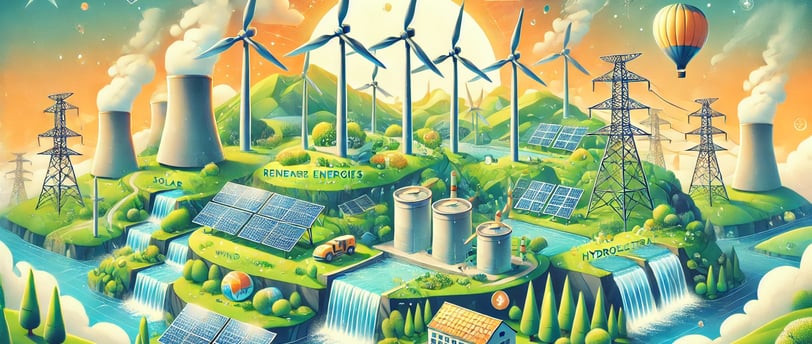Types of Renewable Energies: The Future of Sustainable Power
Dive into the different types of renewable energies—solar, wind, hydro, and more—and learn how they are powering a sustainable, cleaner future for everyone.
Jose Rendon


Why Renewable Energies Are the Key to a Sustainable Future
Imagine a world where energy is abundant, clean, and sustainable, without the harmful emissions that contribute to climate change. This is not just a vision; it is an achievable reality through the use of renewable energies. But what exactly are renewable energies, and what types exist? Let’s dive deep into the types of renewable energies that are shaping the future of our planet.
What Are Renewable Energies?
Renewable energies are sources of power derived from natural processes that are replenished constantly. Unlike fossil fuels, these sources are sustainable and have minimal environmental impact. Examples include solar, wind, hydro, geothermal, and biomass energy.
Why Are Renewable Energies Important?
Renewable energies reduce greenhouse gas emissions, lower air pollution, and contribute to energy independence. They are essential for combating climate change and transitioning towards a cleaner, more sustainable future.
Types of Renewable Energies
1. Solar Energy
What Is Solar Energy?
Solar energy harnesses the power of the sun to generate electricity or heat. This is achieved using photovoltaic (PV) panels or solar thermal systems.
How Does Solar Energy Work?
Photovoltaic panels convert sunlight directly into electricity, while solar thermal systems use mirrors or lenses to concentrate sunlight and produce heat, which can drive turbines for electricity generation.
Advantages of Solar Energy
Abundant and inexhaustible source
Reduces electricity bills
Minimal maintenance costs
Disadvantages of Solar Energy
Intermittent (depends on sunlight)
High initial costs
Requires large areas for large-scale deployment
2. Wind Energy
What Is Wind Energy?
Wind energy converts the kinetic energy of the wind into electricity using wind turbines.
How Does Wind Energy Work?
As the wind blows, it spins the turbine blades, which drive a generator to produce electricity.
Advantages of Wind Energy
Clean and sustainable
Cost-effective over time
Suitable for remote areas
Disadvantages of Wind Energy
Intermittent (depends on wind conditions)
Noise and aesthetic concerns
Impact on wildlife (birds and bats)
3. Hydropower (Hydroelectric Energy)
What Is Hydropower?
Hydropower uses the energy of flowing or falling water to generate electricity.
How Does Hydropower Work?
Water is directed through turbines, spinning them to produce electricity. Dams are often used to control water flow.
Advantages of Hydropower
Reliable and consistent
Provides water storage and flood control
High energy output
Disadvantages of Hydropower
Environmental impact (affects aquatic ecosystems)
High construction costs
Limited to regions with suitable water resources
4. Geothermal Energy
What Is Geothermal Energy?
Geothermal energy utilizes heat from within the Earth to produce electricity and heating.
How Does Geothermal Energy Work?
Wells are drilled into geothermal reservoirs to access hot water and steam, which drive turbines to generate electricity.
Advantages of Geothermal Energy
Reliable and consistent
Low operating costs
Minimal land footprint
Disadvantages of Geothermal Energy
Location-specific
High upfront costs
Risk of induced seismicity (earthquakes)
5. Biomass Energy
What Is Biomass Energy?
Biomass energy comes from organic materials, such as wood, crop waste, and animal manure, which are burned or converted into biofuels.
How Does Biomass Energy Work?
The combustion or biochemical conversion of biomass releases energy that can be used to generate electricity or heat.
Advantages of Biomass Energy
Reduces waste
Carbon-neutral (if managed sustainably)
Versatile (can produce heat, electricity, and fuels)
Disadvantages of Biomass Energy
Can contribute to deforestation
Emits pollutants when burned
Requires large areas of land
The Future of Renewable Energies
Technological Innovations
Technological advancements are making renewable energies more efficient and affordable. Innovations include floating solar farms, offshore wind farms, and enhanced geothermal systems.
The Role of Governments and Policies
Governments worldwide are implementing policies to promote renewable energies, including subsidies, tax incentives, and renewable energy targets.
How Individuals Can Contribute
Switching to renewable energy at home, supporting clean energy policies, and investing in energy-efficient appliances are ways individuals can contribute to the renewable energy transition.
Conclusion: A Path Towards a Sustainable Future
The adoption of renewable energies is not just a matter of technology but also of culture and shared values. By embracing this transition, we dare to envision a world where the heartbeat of the Earth is our ally.
Resources
Explore geology and renewable energy here.
© 2024. All rights reserved.
